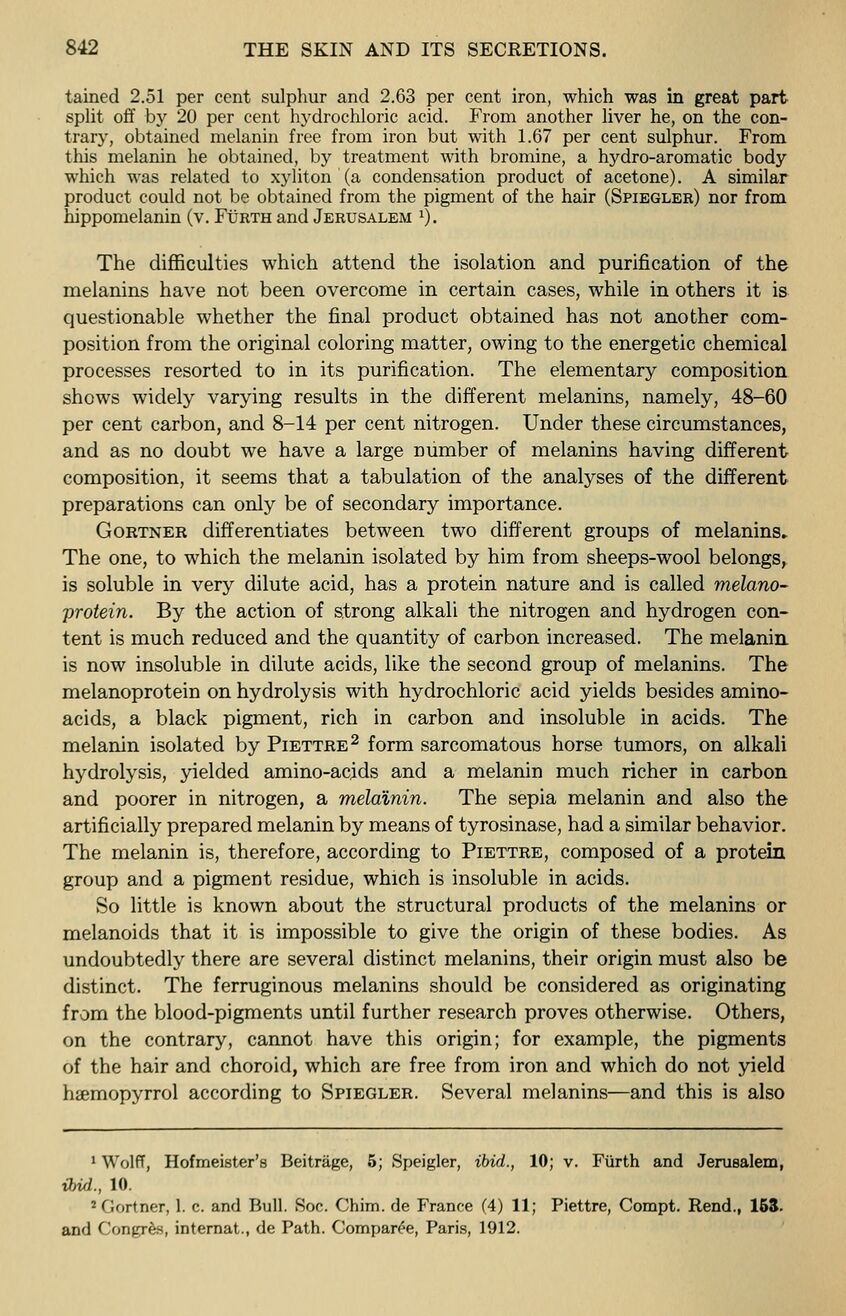
Full resolution (JPEG) - On this page / på denna sida - XV. The Skin and its Secretions

<< prev. page << föreg. sida << >> nästa sida >> next page >>
Below is the raw OCR text
from the above scanned image.
Do you see an error? Proofread the page now!
Här nedan syns maskintolkade texten från faksimilbilden ovan.
Ser du något fel? Korrekturläs sidan nu!
This page has never been proofread. / Denna sida har aldrig korrekturlästs.
842 THE SKIN AND ITS SECRETIONS.
tained 2.51 per cent sulphur and 2.63 per cent iron, which was in great part
split off by 20 per cent hydrochloric acid. From another liver he, on the con-
trary, obtained melanin free from iron but with 1.67 per cent sulphur. From
this melanin he obtained, by treatment with bromine, a hydro-aromatic body
which was related to xyliton (a condensation product of acetone). A similar
product could not be obtained from the pigment of the hair (Spiegler) nor from
hippomelanin (v. Furth and Jerusalem 1
).
The difficulties which attend the isolation and purification of the
melanins have not been overcome in certain cases, while in others it is
questionable whether the final product obtained has not another com-
position from the original coloring matter, owing to the energetic chemical
processes resorted to in its purification. The elementary composition
shows widely varying results in the different melanins, namely, 48-60
per cent carbon, and 8-14 per cent nitrogen. Under these circumstances,
and as no doubt we have a large number of melanins having different
composition, it seems that a tabulation of the analyses of the different
preparations can only be of secondary importance.
Gortner differentiates between two different groups of melanins.
The one, to which the melanin isolated by him from sheeps-wool belongs,
is soluble in very dilute acid, has a protein nature and is called melano-
protein. By the action of strong alkali the nitrogen and hydrogen con-
tent is much reduced and the quantity of carbon increased. The melanin
is now insoluble in dilute acids, like the second group of melanins. The
melanoprotein on hydrolysis with hydrochloric acid yields besides amino-
acids, a black pigment, rich in carbon and insoluble in acids. The
melanin isolated by Piettre 2
form sarcomatous horse tumors, on alkali
hydrolysis, yielded amino-acids and a melanin much richer in carbon
and poorer in nitrogen, a melainin. The sepia melanin and also the
artificially prepared melanin by means of tyrosinase, had a similar behavior.
The melanin is, therefore, according to Piettre, composed of a protein
group and a pigment residue, which is insoluble in acids.
So little is known about the structural products of the melanins or
melanoids that it is impossible to give the origin of these bodies. As
undoubtedly there are several distinct melanins, their origin must also be
distinct. The ferruginous melanins should be considered as originating
from the blood-pigments until further research proves otherwise. Others,
on the contrary, cannot have this origin; for example, the pigments
of the hair and choroid, which are free from iron and which do not yield
hamopyrrol according to Spiegler. Several melanins—and this is also
1
Wolff, Hofmeister’s Beitrage, 5; Speigler, ibid., 10; v. Furth and Jerusalem,
ibid., 10.
2 Gortner, 1. c. and Bull. Soc. Chim. de France (4) 11; Piettre, Compt. Rend., 153.
and Congres, internat., de Path. Comparee, Paris, 1912.
<< prev. page << föreg. sida << >> nästa sida >> next page >>